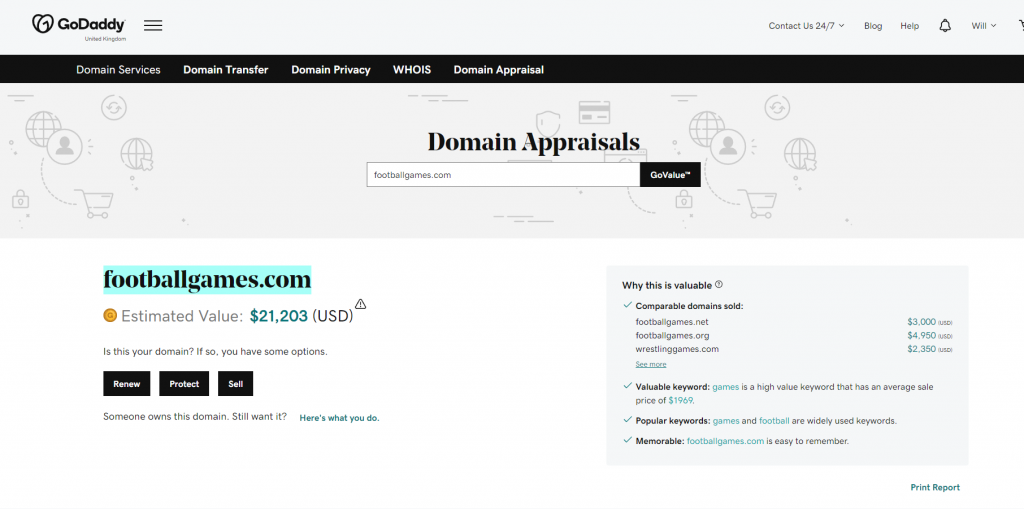How to Sell a Domain Name: The 2024 Guide
Like digital real estate, domain names can be worth a lot of money. The most expensive domain name ever sold was Cars.com, valued at an astounding $872 million. While it’s unlikely that you’ll have a domain in your portfolio worth quite so much, there’s still a good chance you could sell your domain names for a tidy profit. Notably, premium domains have been fetching impressive sales — marketing.com, for example, sold for just short of £2 million in 2023.
Here’s what you need to consider when attempting to sell your domain names.
How to sell a domain name
1. Work out the value of the domain name you want to sell
2. Choose where to sell your domain name
3. Let people know your domain is for sale
4. Create a domain listing
5. Choose a payment service
6. Transfer your domain
Work out the value of the domain name
How much is your domain worth? While you can make an educated guess, there are tools available to help you assess what potential buyers might be willing to pay for a particular domain. GoDaddy offers a domain valuation tool that can assist you in this process.
Remember, a domain name is only worth what someone else is willing to pay for it. While valuation tools can provide guidance, they don’t guarantee a specific sale price.
GoDaddy, our partner company, offers a domain valuation tool.

You can also research what similar domains have sold for, and the GoDaddy valuation tool can help with this as well. For instance, some of the most expensive domain names ever sold contain only five to eight characters, such as floor.com, which sold for over $3.1 million.
Added to that, think about factors that contribute to domain value appraisal, including:
Traffic: Domains with pre-existing traffic tend to be more valuable as they have a higher chance of ranking well on search engines.
Keywords: Keyword-rich domains are more appealing since they can improve a website’s search engine optimisation (SEO) and increase click-through rates.
Length: Shorter domains are usually better, as they’re easier to remember.
Top-Level Domain (TLD): Domains with reputable extensions like .com or .net often command higher prices.
Finally, you can list your domain for sale and see what kind of offers you receive, but be prepared for the possibility of low offers.
The potential profitability of domain flipping
Flipping domains has become a profitable business where people buy valuable domain names and sell them for a profit. This industry is so attractive that many entrepreneurs have started doing it as a side job or full-time career. Successful full-time domain flippers can earn up to £100,000 a year. The possibility of making a lot of money can be a motivating factor for those thinking about this business model.
Choose how to sell your domain
When deciding how to choose your domain there are two basic things to consider: Which service you’ll use to sell your domain and whether you’ll sell at auction or at a fixed price.
There are plenty of domain broker services out there. 123 Reg doesn’t offer a domain broker service directly, but we have partnered with GoDaddy to help you sell your unwanted domains. Broker services will usually charge a commission for selling your domain, but the upside is that they usually have a large audience of interested buyers. Other broker services include Sedo, Flippa and Afternic.
You could also sell your domain privately and/or use eBay to do so. This may be cheaper than using a domain broker, but you will have to promote the sale entirely on your own.
When it comes to choosing a fixed price vs an auction sale, you’ll probably find that for most domains you’re selling a fixed price works best. Auctions tend to work well for higher-value domains where there will be a lot of competing bidders.
Let people know your domain is for sale
The more potential buyers you can attract to your domain the better, so it makes sense to let people know that your domain name is up for sale.
There are a number of ways you can do this. Most domain broker services will ensure that your website is advertised for sale when someone visits the URL. Your domain name will also be displayed on the broker’s site, although people may have to search to find it.
You can also let people know that your domain is for sale via social media, domain investing forums and email outreach. Note: It’s probably only worth letting domain investing forums know you’re selling a domain if it’s an extremely premium domain that will attract a lot of attention. Email outreach works well for domains linked to professional services.
See also: The Most Expensive Domain Names Ever Sold
Prepare your domain listing
The basics of your domain listing are the domain you’re selling and the price you’re charging (or, if it’s an auction, the starting bid.)
However, some domain listing companies allow you to provide additional information and, if you’ve picked one that does, this is something you should take advantage of.
If possible, make sure your listing description includes details of past usage for the domain and potential future uses.
Arrange a payment option
Selling a domain name can involve a large sum of money, so you’ll want to make sure you put in place a payment method which allows you to sell with confidence and which means buyers know they’re protected too.
If you’re using a domain broker service, they will handle this side of things for you. However, it’s a good idea to familiarize yourself with the way the transaction will be dealt with so you know what to expect.
If you decide to sell a domain by yourself, you’ll need to arrange a payment method that’s safe and secure. Usually, you’ll need to use an escrow service. With escrow payment, the money is held by a third party while the purchase takes control of the item in question (in this case your domain name) once the transfer is complete, the release the payment. Escrow is the system usually used by domain brokers.
By using escrow, you don’t have to worry about a fraudulent payment and buyers don’t have to worry they won’t get the domain after they’ve paid their cash.
Transfer your domain name
Once your domain has been sold and the payment has entered escrow, you’ll need to transfer your domain to the new owner. Domain transfers can vary based on the extension of your domain and the provider you’re using. You can refer to a general guide on domain transfers, but for specific information, check your provider’s help section or contact them directly.
The general process for transferring a domain to someone else is:
1. You contact your domain registrar and tell them you want to move the domain to someone else
2. Your domain registrar will use a verification method to ensure that you own the domain and wish to transfer ownership
3. You have 60 days to confirm the transfer, once you have done this the domain will be transferred to the new owner
4. In the case of a domain purchase, the funds will now be released to you from escrow
Important note: Important note: While you have 60 days to confirm the transfer with your domain registrar, the terms of your sale may require you to do it sooner. Additionally, per ICANN rules, if you’ve created or transferred your domain name in the last 60 days, it is not eligible for transfer. This 60-day rule is crucial for ensuring compliance and avoiding delays in your transfer process. Be mindful that if your domain is subject to a 60-day Change of Registrant lock, this will also prevent the transfer. This rule is in place to protect you against unauthorized transfers.
See also: Names That Click – How to Choose the Right Domain Name
Reasons for transfer failure
When transferring a domain registration, there are specific reasons why a transfer may fail. To ensure a successful transfer, be aware of the following common issues:
Domain is Locked or On Hold: Most domains will have a Registrar Lock in place for added security. You should have access to remove this lock directly within your account at your registrar. If the domain has a hold in place, it will be reflected in the domain status when you do a WHOIS lookup. These holds are usually put in place at either the registry or registrar level, and you will need to contact the losing registrar for assistance in removing them.
Domain Age: Per ICANN regulations, a domain that is less than 60 days old or has been transferred between registrars within the last 60 days is not eligible for transfer. Ensure your domain has been registered for at least 60 days before initiating a transfer.
How long do domain transfers take?
Knowing how long it takes to move your website to a new domain is important. Typically, the domain transfer process can take anywhere from a few minutes to up to 7 days, depending on various factors. If your domain transfer is taking longer than expected, don’t panic. The transfer may take up to 7 days to complete due to security measures designed to prevent fraudulent transfers. For example, if your domain is locked, you must unlock it before initiating the transfer process, and ensure that your email ID matches the WHOIS database.
Wrapping up
If you want to sell a domain, it’s important to start by working out how much it’s worth. You also need to find a safe and secure way of selling your domain, you’ll probably want to go with an established domain broker service like the one offered by GoDaddy. Finally, make sure you use a safe and secure payment method and that you know how to complete the domain transfer when needed.

